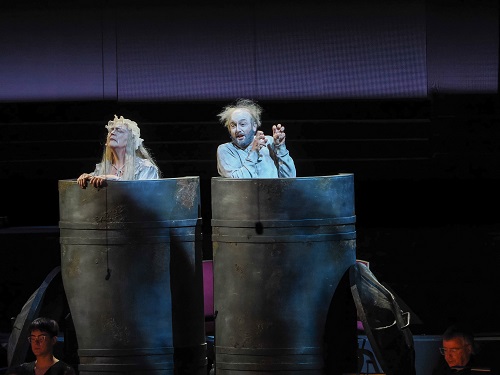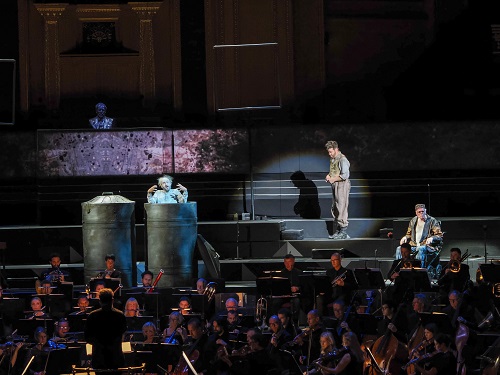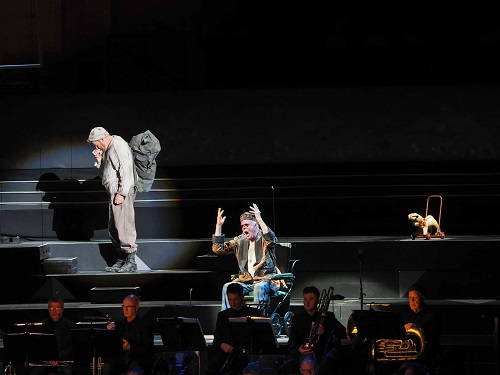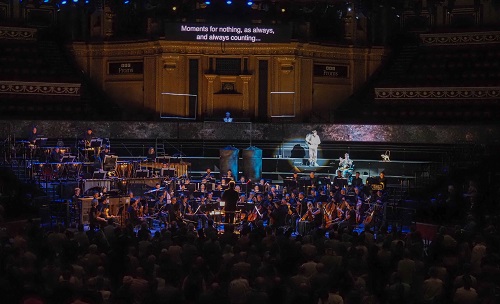What sort of music might capture the enigmatic nihilism of Samuel Beckett’s Endgame? The play’s fragmentation and dislocation? Its seemingly pointless patterns of repetition and variation? György Kurtág’s aphoristic stutters, whispers and sighs – the painstaking development and fusion of intervallic relationships and timbre, the fragility of a butterfly’s wing married to a framework of steel – would seem to be the perfect idiom. But, at the end of this UK premiere of Kurtág’s 2018 opera, performed at the Proms by the BBC Scottish Symphony Orchestra conducted by Ryan Wigglesworth, another question came to mind: can, or even should, one set this play to music at all? Does the presence of music, which fills in the silences, infringe upon Beckett’s denial, or at least avoidance, of significance, of ‘meaning’? And on the play’s own inherent musicality?
Kurtág first saw Beckett’s play in 1957, in Paris, on the recommendation of György Ligeti. After a gestation period of 60 years, he began composition, but age and ill health hindered progress. In a video posted on YouTube by The BBVA Foundation in June 2015 (but no longer available), the composer remarked, “The only thing that I can say is that I have been working on it for over four years and I still cannot see the end of it, I might die before I finish it, but I want to strive until the very end to interpret Beckett”. Though he announced it as complete in 2015, the premiere of the opera was cancelled and rescheduled three times; it was finally performed in November 2018 at La Scala, directed by Pierre Audi. The cast comprised Frode Olsen as Hamm, Leigh Melrose as Clov, Hilary Summers as Nell and Leonardo Cortellazzi as Nagg, three of whom returned to these roles at the Royal Albert Hall. In a sense, though, it is a ‘work-in-progress’, as the now 97-year-old Kurtág has suggested that he might add further ‘scenes and monologues’. As Hamm says, “The end is in the beginning and yet you go on”. And, by Kurtág’s standards it’s a long score: quite a few audience members thought too long, judging by the departing footfall during the performance.

Kurtág sets the original French text (indeed his title for the opera is Fin de partie), and it was performed in French at the RAH, with English surtitles – a little confusing for those Radio 3 listeners, perhaps. The play is a four-hander, the characters divided into two pairs. Hamm, blind, slumped in a wheelchair, has a servant, Clov, who hobbles about, mechanically carrying out Hamm’s commands, subservient and reluctantly obedient. Hamm’s parents, Nagg and Nell, are legless and live in dustbins. They pop up their heads, call for food, comfort each other, and then die.
The libretto sets about 60% of the original text, divided into twelve episodes with a double prologue and epilogue. What is lost by the excisions is the intensity of the relationship between Hamm and Clov, the one unable to move, the other unable to leave, which dominates the play. The editing also weakens the play’s overwhelming sense of repetition, as gestures, words and phrases recur, never quite the same.
Though, perhaps, this is something that Kurtág’s score does restore, with its meticulous, microscopic developments and variations? And, some critics have explored the musicality of Beckett’s theatre. Claudia Olk, for example, writes of the structural elements of music and rhythm that are inherent in Beckett’s aesthetics and investigates the musical processes that are at play in Endgame, reminding us that ‘Beckett conceived of drama much in terms of music. “Drama is following music”, he writes, “I never write a word without first saying it out loud”.’[1] In contrast, Thomas Mansell comments on ‘[t]he thoroughness with which music is eradicated from Endgame’.[2] Hamm, after all, forbids Clov to sing.

It seems an odd decision, too, to begin – after a short orchestral introduction – with a ‘Prologue’ sung by Nell: a setting of Beckett’s poem, ‘Roundelay’, in English (and which, here, Summers delivered through a window frame aloft). For, while the poem’s sibilance and assonance might initiate the repetitiveness of the action, the first words of the play are Clov’s: “[Fixed gaze, tonelessly] Finished, it’s finished, nearly finished, it must be nearly finished. [Pause.]” And, it is with these words that surely the endgame must begin?
Beckett’s setting is a claustrophobic one: a bare room, grey light, a picture – faced turned towards the wall – beside a door, two small windows high up. In the play (though not the opera), Hamm repeatedly asks Clov to help him confirm the parameters of the confined space, through the movement of his wheelchair. The RAH isn’t the best place to recreate this oppressive interior. The semi-staging (Victoria Newlyn) did allow us to witness Clov’s pained, shuffling entrances and exits, behind the orchestra; and, in the opening mime, he climbed up a ladder to gaze through one of the large window frames perched beneath the organ (I did wonder if, from some angles in the Hall, the frames might make a portrait of the bust of Henry Wood).
There were some projections – ripples of the deep Lake Como blue, the gaudy grins of vaudeville clowns – which rather went against Beckett’s monochrome miseries. Newlyn misjudged the stage layout too, placing the two huge dustbins centre-stage when Beckett’s opening stage instructions explicitly state, ‘Centre, in an armchair on castors, covered with an old sheet, HAMM’. Beckett choreographs the action with utmost care. And, it is Hamm who dominates this ‘action’: it was a mistake to place his wheelchair on far stage-left. Even after the lids had come down on Nell and Nagg, and despite some subtle lighting shifts, their dustbin-residences still dominated.

Whatever misgivings, of various kinds, I might express, I have nothing but admiration for the performers. Kurtág’s scoring is meticulous and transparent, allowing every word of text to be heard, just as his harmonies are surprising consonant, and helpfully support the vocal lines. The latter are often recitative-like, restrained until they swell with anguish. The singers were utterly committed. Olsen’s Hamm was fiercely combative but proud too, even at the close when his final hopes for deliverance brought almost painful lyricism. As Clov, Moody brought forth all the character’s complexities and contradictions, as he prowled the platform like a wounded animal, all guttural discontentment and growling resentment. Nell’s reminisces about Lake Como were poignant, Hilary Summers using variety of colour, dynamic and weight with extraordinary subtlety. The ghostly whiteness of her visage was haunting. One had empathy, too, with Leonardo Cortellazzi’s over-excited Nagg, as he tried to share a (dog) biscuit with his wife, not realising that she is dying. His exclamation, “Nell!”, as he thumped on her dustbin lid, was heart-breaking, as was his subsequent resignation.
Ryan Wiggleworth’s command of the score was consummate. Every detail was finely etched, from the horseblock that animates Nagg’s story of the tailor who annoys his client by taking too long to make a pair of trousers, to the glockenspiel and pizzicato strings that are clicking inside Hamm’s head, or the wheezing accordions (bayans) that join in a bizarre waltz. Disparate instruments – tuba and string harmonics, grunting bassoons and vaudeville percussion – were paired with pointedness.

In his 1962 book, The Theatre of the Absurd, Martin Esslin notes that ‘absurd’ was originally defined in a musical context – it meant ‘out of harmony’. Notions of incongruity and illogic came later. But, for all that Eugène Ionesco, in an essay on Kafka, suggested that the absurd is that which is ‘devoid of purpose … man is lost; all his actions … senseless, absurd, useless’, Esslin finds that although there is a breakdown of conventional methods of communication, there are recurring gestures within the theatre of the absurd – mime, gesture, pauses and silences. Do these gestures ‘communicate’, and if so, what? Despite the absence of ideological presumptions or social expectations, a blind man in a wheelchair and a limping servant might signify ‘something’, perhaps? Something, about the human predicament?
This performance has made me reflect – or revisit a topic of obsession – on the relationship between music and words. Does Kurtág return to a sort of Monteverdian ideology? Given that most of the scenes are shaped around solipsistic soliloquies, would a cantata-style presentation be more apt? Or, would his score work as an instrumental suite, perhaps with mimed gestures? And, should a musical adaptation respect Beckett’s scrupulous instructions, in the stage directions, that there should be a pause or a silence – instructions which he himself observed rigorously when he was directing. For such silences are hollow, echoey chambers – both in the abstract and within the theatre-goer’s mind – in which the spoken words resonate and dwell.
The characters in Endgame are in limbo. There can be no dramatic resolution, no clear ending. And so, too, there is probably no answer to the question which I asked myself at the start: does Kurtág’s score embody, complement, enhance the semiotics of Beckett’s drama, or does it shatter the essential absurdity that is its silence?
Claire Seymour
György Kurtág: Endgame
Hamm – Frode Olsen, Clov – Morgan Moody, Nell – Hilary Summers, Nagg – Leonardo Cortellazzi, BBC Scottish Symphony Orchestra, Ryan Wigglesworth (conductor), Victoria Newlyn (stage director)
Royal Albert Hall, London; Thursday 17th August 2023.
[1] Claudia Olk (2011) ‘A Matter of Fundamental Sounds: The Music of Beckettʼs Endgame’, Poetica, Volume 43, Issue 3-4, pp. 391–410.
[2] Thomas ManseIl (2007) ‘Hard-to-hear Music in Endgame’, in Samuel Beckett’s ‘Endgame’, ed. Mark S. Byron, Amsterdam/New York: Rodopi, pp.1-23.